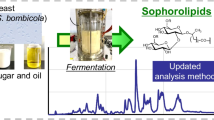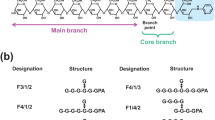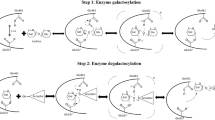Abstract
The marine bacteria Saccharophagus degradans (also known as Microbulbifer degradans), are rod-shaped and gram-negative motile γ-proteobacteria, capable of both degrading a variety of complex polysaccharides and fermenting monosaccharides into ethanol. In order to obtain insights into structure–function relationships of the enzymes, involved in these biochemical processes, we characterized a S. degradans β-glycosidase from glycoside hydrolase family 1 (SdBgl1B). SdBgl1B has the optimum pH of 6.0 and a melting temperature T m of approximately 50 °C. The enzyme has high specificity toward short d-glucose saccharides with β-linkages with the following preferences β-1,3 > β-1,4 ≫ β-1,6. The enzyme kinetic parameters, obtained using artificial substrates p-β-NPGlu and p-β-NPFuc and also the disaccharides cellobiose, gentiobiose and laminaribiose, revealed SdBgl1B preference for p-β-NPGlu and laminaribiose, which indicates its affinity for glucose and also preference for β-1,3 linkages. To better understand structural basis of the enzyme activity its 3D model was built and analysed. The 3D model fits well into the experimentally retrieved low-resolution SAXS-based envelope of the enzyme, confirming monomeric state of SdBgl1B in solution.








Similar content being viewed by others
References
Dias, M. O. S., Junqueira, T. L., Cavalett, O., Cunha, M. P., Jesus, C. D. F., Rossell, C. E. V., et al. (2012). Integrated versus stand-alone second generation ethanol production from sugarcane bagasse and trash. Bioresource Technology, 103(1), 152–161. doi:10.1016/j.biortech.2011.09.120.
Singhania, R. R., Patel, A. K., Sukumaran, R. K., Larroche, C., & Pandey, A. (2013). Role and significance of beta-glucosidases in the hydrolysis of cellulose for bioethanol production. Bioresource Technology, 127, 500–507. doi:10.1016/j.biortech.2012.09.012.
Phillips, C. M., Beeson, W. T., Cate, J. H., & Marletta, M. A. (2011). Cellobiose dehydrogenase and a copper-dependent polysaccharide monooxygenase potentiate cellulose degradation by Neurospora crassa. ACS Chemical Biology, 6, 1399–1406. doi:10.1021/cb200351y.
Mohanram, S., Amat, D., Choudhary, J., Arora, A., & Nain, L. (2013). Novel perspectives for evolving enzyme cocktails for lignocellulose hydrolysis in biorefineries. Sustainable Chemical Processes, 1(1), 15. doi:10.1186/2043-7129-1-15.
Ensor, L. A., Stosz, S. K., & Weiner, R. M. (1999). Expression of multiple complex polysaccharide-degrading enzyme systems by marine bacterium strain 2-40. Journal of Industrial Microbiology and Biotechnology, 23(2), 123–126. doi:10.1038/sj.jim.2900696.
Taylor, L. E., Henrissat, B., Coutinho, P. M., Ekborg, N. A., Hutcheson, S. W., & Weiner, R. M. (2006). Complete cellulase system in the marine bacterium Saccharophagus degradans Strain 2-40(T). Journal of Bacteriology, 188(11), 3849–3861. doi:10.1128/JB.01348-05.
Ekborg, N. A., Gonzalez, J. M., Howard, M. B., Taylor, L. E., Hutcheson, S. W., & Weiner, R. M. (2005). Saccharophagus degradans gen. nov., sp. nov., a versatile marine degrader of complex polysaccharides. International Journal of Systematic and Evolutionary Microbiology, 55(4), 1545–1549. doi:10.1099/ijs.0.63627-0.
Shin, M. H., Lee, D. Y., Skogerson, K., Wohlgemuth, G., Choi, I.-G., Fiehn, O., et al. (2010). Global metabolic profiling of plant cell wall polysaccharide degradation by Saccharophagus degradans. Biotechnology and Bioengineering, 105(3), 477–488. doi:10.1002/bit.22557.
Robert, X., & Gouet, P. (2014). Deciphering key features in protein structures with the new ENDscript server. Nucleic Acids Research, 42(W1), W320–W324. doi:10.1093/nar/gku316.
Isorna, P., Polaina, J., Latorre-García, L., Cañada, F. J., González, B., & Sanz-Aparicio, J. (2007). Crystal structures of Paenibacillus polymyxa beta-glucosidase B complexes reveal the molecular basis of substrate specificity and give new insights into the catalytic machinery of family I glycosidases. Journal of Molecular Biology, 371(5), 1204–1218. doi:10.1016/j.jmb.2007.05.082.
Yamamoto, K., Miyake, H., Kusunoki, M., & Osaki, S. (2011). Steric hindrance by 2 amino acid residues determines the substrate specificity of isomaltase from Saccharomyces cerevisiae. Journal of Bioscience and Bioengineering, 112(6), 545–550. doi:10.1016/j.jbiosc.2011.08.016.
Hassan, N., Nguyen, T.-H., Intanon, M., Kori, L., Patel, B. C., Haltrich, D., et al. (2015). Biochemical and structural characterization of a thermostable β-glucosidase from Halothermothrix orenii for galacto-oligosaccharide synthesis. Applied Microbiology and Biotechnology, 99(4), 1731–1744. doi:10.1007/s00253-014-6015-x.
Matsuzawa, T., Jo, T., Uchiyama, T., Manninen, J. A., Arakawa, T., Miyazaki, K., et al. (2016). Crystal structure and identification of a key amino acid for glucose tolerance, substrate specificity and transglycosylation activity of metagenomic β-glucosidase Td2F2. The FEBS Journal,. doi:10.1111/febs.13743.
Camilo, C. M., & Polikarpov, I. (2014). High-throughput cloning, expression and purification of glycoside hydrolases using ligation-independent cloning (LIC). Protein Expression and Purification, 99, 35–42. doi:10.1016/j.pep.2014.03.008.
Petersen, T., Brunak, S., von Heij, H. G., & Nielson, H. (2011). SignalP 4.0: discriminating signal peptides from transmembrane regions. Nature Methods, 8, 785–786.
Neuhoff, V., Stamm, R., & Eibl, H. (1985). Clear background and highly sensitive protein staining with Coomassie blue dyes in polyacrylamide gels: A systematic analysis. Electrophoresis, 6(9), 427–448. doi:10.1002/elps.1150060905.
Zhang, Y. H. P., & Lynd, L. R. (2004). Toward an aggregated understanding of enzymatic hydrolysis of cellulose: Noncomplexed cellulase systems. Biotechnology and Bioengineering, 88, 797–824.
Miller, G. L. (1959). Use of dinitrosalicylic acid reagent for determination of reducing sugar. Analytical Chemistry, 31(3), 426–428. doi:10.1021/ac60147a030.
Leatherbarrow, R. J. (1987). Enzfitter A non-linear regression data analysis program for the IBM PC. Amsterdam: Elsevier.
Provencher, S. W. (1982). CONTIN: A general purpose constrained regularization program for inverting noisy linear algebraic and integral equations. Computer Physics Communications, 27(3), 229–242. doi:10.1016/0010-4655(82)90174-6.
Hammersley, A. (1997). FIT2D: An introduction and overview. Grenoble: European Synchrotron Radiation Source.
Petoukhov, M. V., Franke, D., Shkumatov, A. V., Tria, G., Kikhney, A. G., Gajda, M., et al. (2012). New developments in the ATSAS program package for small-angle scattering data analysis. Journal of Applied Crystallography, 45(2), 342–350. doi:10.1107/S0021889812007662.
Svergun, D. I. (1992). Determination of the regularization parameter in indirect-transform methods using perceptual criteria. Journal of Applied Crystallography, 25, 495–503.
Franke, D., & Svergun, D. I. (2009). DAMMIF, a program for rapid ab initio shape determination in small-angle scattering. Journal of Applied Crystallography, 42(2), 342–346. doi:10.1107/S0021889809000338.
Petoukhov, M. V., & Svergun, D. I. (2013). Applications of small-angle X-ray scattering to biomacromolecular solutions. The International Journal of Biochemistry & Cell Biology, 45(2), 429–437. doi:10.1016/j.biocel.2012.10.017.
Kozin, M. B., & Svergun, D. I. (2001). Automated matching of high- and low-resolution structural models. Journal of Applied Crystallography, 34, 33–41.
Svergun, D., Barberato, C., & Koch, M. H. J. (1995). CRYSOL—A program to evaluate X-ray solution scattering of biological macromolecules from atomic coordinates. Journal of Applied Crystallography, 28(6), 768–773.
Fischer, H., de Oliveira Neto, M., Napolitano, H. B., Polikarpov, I., & Craievich, A. F. (2010). Determination of the molecular weight of proteins in solution from a single small-angle X-ray scattering measurement on a relative scale. Journal of Applied Crystallography, 43(1), 101–109. doi:10.1107/S0021889809043076.
Zhang, Y. (2008). I-TASSER server for protein 3D structure prediction. BMC Bioinformatics, 9(1), 40. doi:10.1186/1471-2105-9-40.
Lombard, V., Golaconda Ramulu, H., Drula, E., Coutinho, P. M., & Henrissat, B. (2014). The carbohydrate-active enzymes database (CAZy) in 2013. Nucleic Acids Research, 42(D1), D490–D495. doi:10.1093/nar/gkt1178.
Turan, Y. (2008). A pseudo-β-glucosidase in Arabidopsis thaliana: Correction by site-directed mutagenesis, heterologous expression, purification, and characterization. Biochemistry (Moscow), 73(8), 912–919. doi:10.1134/S0006297908080099.
Gao, J., & Wakarchuk, W. (2014). Characterization of five β-glycoside hydrolases from Cellulomonas fimi ATCC 484. Journal of Bacteriology, 196(23), 4103–4110. doi:10.1128/JB.02194-14.
Feigin, L. A., & Svergun, D. I. (1987). General principles of small-angle diffraction. In G. W. Taylor (Ed.), Structure analysis by small-angle X-ray and neutron scattering (pp. 25–55). New York: Springer. doi:10.1007/978-1-4757-6624-0.
Schmidt, M., Nerger, D., & Burchard, W. (1979). Quasi-elastic light scattering from branched polymers: 1. Polyvinylacetate and polyvinylacetate-microgels prepared by emulsion polymerization. Polymer, 20(5), 582–588.
Chen, Z.-Y., Weakliem, P. C., & Meakin, P. (1988). Hydrodynamic radii of diffusion-limited aggregates and bond-percolation clusters. The Journal of Chemical Physics, 89(9), 5887. doi:10.1063/1.455732.
Senff, H., & Richtering, W. (1999). Temperature sensitive microgel suspensions: Colloidal phase behavior and rheology of soft spheres. The Journal of Chemical Physics, 111(4), 1705–1711.
Dünweg, B., Reith, D., Steinhauser, M., & Kremer, K. (2002). Corrections to scaling in the hydrodynamic properties of dilute polymer solutions. The Journal of Chemical Physics, 117(2), 914. doi:10.1063/1.1483296.
Rambo, R. P., & Tainer, J. A. (2011). Characterizing flexible and intrinsically unstructured biological macromolecules by SAS using the Porod-Debye law. Biopolymers, 95(8), 559–571. doi:10.1002/bip.21638.
Kachala, M. (2015). Development of methods to analyze and represent small-angle scattering data from interacting and flexible biological macromolecules. Universität Hamburg.
Hammel, M. (2012). Validation of macromolecular flexibility in solution by small-angle X-ray scattering (SAXS). EBJ European Biophysics Journal, 41(10), 789–799. doi:10.1007/s00249-012-0820-x.
Yang, J., Yan, R., Roy, A., Xu, D., Poisson, J., & Zhang, Y. (2014). The I-TASSER Suite: Protein structure and function prediction. Nature Methods, 12(1), 7–8. doi:10.1038/nmeth.3213.
Wang, X., He, X., Yang, S., An, X., Chang, W., & Liang, D. (2003). Structural basis for thermostability of β-glycosidase from the thermophilic eubacterium Thermus nonproteolyticus HG102. Journal of Bacteriology, 185(14), 4248–4255.
Nam, K. H., Kim, S.-J., Kim, M.-Y., Kim, J. H., Yeo, Y.-S., Lee, C.-M., et al. (2008). Crystal structure of engineered beta-glucosidase from a soil metagenome. Proteins, 73(3), 788–793. doi:10.1002/prot.22199.
de Giuseppe, P. O., Souza, T. D. A. C. B., Souza, F. H. M., Zanphorlin, L. M., Machado, C. B., Ward, R. J., et al. (2014). Structural basis for glucose tolerance in GH1 β-glucosidases. Acta Crystallographica. Section D: Biological Crystallography, 70(6), 1631–1639. doi:10.1107/S1399004714006920.
Zanphorlin, L. M., de Giuseppe, P. O., Honorato, R. V., Tonoli, C. C. C., Fattori, J., Crespim, E., et al. (2016). Oligomerization as a strategy for cold adaptation: Structure and dynamics of the GH1 β-glucosidase from Exiguobacterium antarcticum B7. Scientific Reports, 6, 23776. doi:10.1038/srep23776.
Acknowledgments
The work was supported by the Grants from Brazilian funding agencies Fundação de Amparo à Pesquisa do Estado de São Paulo (FAPESP)#2008/56255-9; Conselho Nacional de Desenvolvimento Científico e Tecnológico (CNPq)#490022/2009-0,#158752/2015-5 and by a collaborative Grant agreement between the University of Hamburg, Germany and the University of Sao Paulo (USP), Brazil.
Author information
Authors and Affiliations
Corresponding author
Rights and permissions
About this article
Cite this article
Brognaro, H., Almeida, V.M., de Araujo, E.A. et al. Biochemical Characterization and Low-Resolution SAXS Molecular Envelope of GH1 β-Glycosidase from Saccharophagus degradans . Mol Biotechnol 58, 777–788 (2016). https://doi.org/10.1007/s12033-016-9977-3
Published:
Issue Date:
DOI: https://doi.org/10.1007/s12033-016-9977-3




